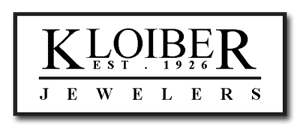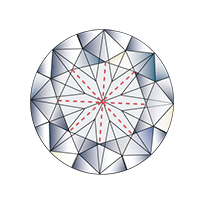Diamond Polish and Symmetry
Posted on Wednesday, October 20th, 2021
in Diamond.
There are various factors that determine the quality and cost of a diamond. Commonly referred to as the 4 C’s, a diamond’s cut, clarity, color, and carat weight all affect the value of a diamond. Often considered the most important quality factor, a diamond’s cut refers to how well its facets (carefully angled flat surfaces) interact with light. The best cut diamonds are those cut in a manner to create desirable visual effects, like brightness, fire, and scintillation.
After a rough diamond is cut, the cutter will polish the gemstone to create a smooth finish. If you’ve ever looked at a diamond grading report, you may have noticed the grades next to polish and symmetry and wondered what exactly that refers to. Both polish and symmetry help determine the overall quality of a diamond’s finish and can affect the cut grade and overall beauty of a diamond.
Polish refers to the smoothness and condition of the diamond’s surface after the diamond has been cut. When determining a diamond’s polish grade, gemologists will look for the presence and visibility of certain features at 10x magnification. These polish features include:
- Nick: A small notch on a facet junction, usually along the girdle or at the culet
- Pit: A tiny opening appearing as a white dot
- Scratch: A surface mark, normally seen as a fine white line that may be curved or straight
- Abrasion: An area of minute scratches or pits along a facet edge producing a fuzzy white line instead of a sharp facet junction
- Lizard Skin: A transparent, uneven texture confined to one facet
- Burn: Whitish haze caused by excessive heat
- Laser Manufacturing Remnant: A remnant of laser manufacturing that remains on the surface of the polished diamond
- Rough Girdle: An irregular pitted or granular surface of a bruted girdle due to pits and nicks
- Polish Lines: Parallel lines left by the polishing process that may appear white or transparent
Symmetry refers to the alignment of a diamond’s facets. A diamond’s symmetry grade is determined by the presence and visibility of symmetry deviations at 10x magnification. When facets are misaligned, it’s often done on purpose to either retain some of the diamond’s weight or remove inclusions. Symmetry variations include unequal crown angles, an off-center culet, extra facets, variation in girdle thickness, missing facets, unequal pavilion angles, and more.
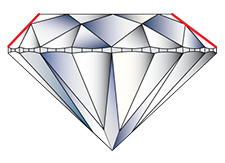
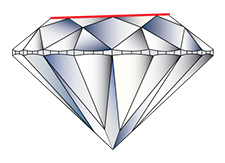
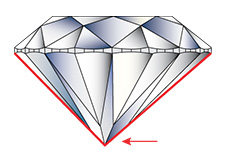
Like diamond cut, a diamond’s polish and symmetry can be assigned one of five grades: Excellent, Very Good, Good, Fair, or Poor. Diamonds with poor polish can appear dull while those with excellent polish often show clear, crisp reflections. Diamonds with poor symmetry won’t return light as well as diamonds with excellent symmetry, meaning you’ll likely notice less sparkle in diamonds with poor symmetry.
For larger round diamonds, we recommend selecting a diamond with a polish and symmetry grade of Very Good or Excellent. For fancy cut diamonds, seek out ones with Good, Very Good, or Excellent polish and symmetry. Try to avoid diamonds with Poor or Fair polish and symmetry. Chances are you won’t notice the difference between a diamond with excellent polish and symmetry vs. a diamond with very good polish and symmetry, but you will likely notice a difference if you compare two diamonds at opposite ends of the grading scale.
While polish and symmetry can have a major effect on the overall beauty of a diamond, there are other factors that have just as much or even more influence on a diamond’s appearance and cut. You also need to take into account other factors like table and depth percentage. That’s why we highly suggest working with a diamond buying expert when looking to purchase your own diamond. They’ll be able to guide you into a selecting a beautiful diamond that’s worth it’s cost.
If you’d like to set up an appointment to look at diamonds with our diamond expert and store owner, Karin, call us at 414-276-2457 or email us at info@kloiberjewelers.com.
